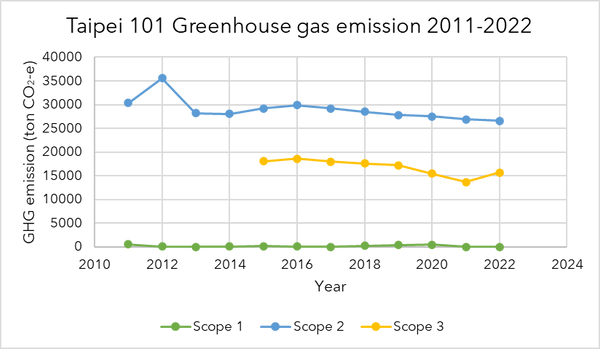
Qualitative
Comparison


SUSTAINABLE SITES
2011: 19/26
2016: 9/10
Score change: +23%

WATER EFFICIENCY
2011: 13/14
2016: 12/12
Score change: +8%

ENERGY & ATMOSPHERE
2011: 23/25
2016: 26/38
Score change: -26%

MATERIAL & RESOURCES
2011: 5/10
2016: 5/8
Score change: +25%

INDOOR ENVIRONMENTAL QUALITY
2011: 12/15
2016: 13/17
Score change: -4%

INNOVATION
2011: 6/6
2016: 6/6
Score change: 0

REGIONAL PRIORITY CREDITS
2011: 4/4
2016: 4/4
Score change: 0


INTEGRATIVE PROCESS CREDITS LOCATION & TRANSPORTATION
2011: All required
2016: 15/20
LEED v4 imposes stricter requirements compared to LEED v2009 across various project types, often leading to a decrease of one certification level when compared to strategies employed under LEED v2009.
In 2011, Taipei 101 obtained its first platinum certification (v3 or v2009) from LEED, becoming the world‘s tallest green building. After the LEED was revised, the Taipei 101 team decided to move forward and take on the challenge of obtaining platinum certification for LEED version 4. The green building performance was enhanced significantly through a series of investments and system upgrades. For more details, please click here. Although the new version of the LEED program is more stringent than before, with outstanding performance in the 6 mandates and different environmental areas, Taipei 101 got 90 marks out of 110 in version 4 of LEED, which showcases that team effort does pay off.
To ensure Taipei 101 is performing as intended and demonstrating leadership long in green buildings, the team will recertify the building by providing 12 months of data in 2021, and this recertification will be valid for 3 years. The recertification process involves the review of Energy, Water, Waste, Transportation, and Indoor Environmental Quality performance. Taipei 101 successfully maintained a level of platinum by a score of 83 over 110. The recertification weighting of different categories differs from the initial certification program, so it cannot be directly compared and concluded whether the performance improved or worsened.
Regardless of the challenges, Taipei 101 has achieved LEED platinum-level certification three times consecutively, showcasing its enduring commitment to sustainable practices

Quantitative
Comparison
Performance data trend

-
From 2009 to 2022, the water consumption per year was reduced by 21.4%
-
Office and shopping mall consumption both showed an obvious decrease in the trend
-
From 2014, Taipei 101 embarked on recording the recycled water amount the total recycled water occupied approximately 2% to 4% (the trend fluctuates)
-
From 2009 to 2022, the energy consumption per year was reduced 14.5%
-
Office and shopping mall consumption both showed a decrease trend
-
Car park energy consumption fluctuated


-
From 2012 to 2022, the domestic waste generation per year slightly reduced by 4.2%
-
The construction waste amount is relatively stable, but the recycled construction waste ratio is reduced yearly
-
Business waste includes commercial and industrial waste, which reduced 17.6% from 2018 to 2022
-
Scope 2 occupied the most significant emission ratio in the GHG inventory of Taipei 101. Its emissions dropped by 12.6% from 2009 to 2022
-
Taipei 101 started to record the scope 3 emission in 2015, which occupied around 33-39% of the total carbon footprint
-
Scope 1 emission is insignificant


The changes are too small? NO!
The occupancy rate of Taipei 101 was around 70% from 2004-2007. In contrast, the rate is between 95-96% in recent years. Hence, the expected energy and water consumption, waste generation, and greenhouse gas emission amount at the early stage is expected to be lower. However, the situation is on the contrary; all the environmental indices showed an enhancement, which means the retrofitting and consumption reduction projects proposed are practical and effective, making Taipei 101 greener and more sustainable.

Reference: Reeves (n.d.)